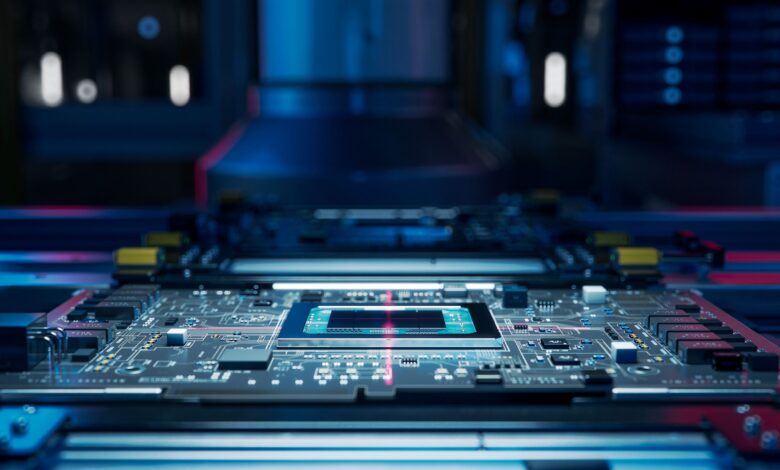
From streamlining chip design to optimising manufacturing and refining supply chain management, AI is driving unprecedented growth in the semiconductor sector. In 2025, data from Brand Finance reveals that the top 30 semiconductor brands reached an aggregate value of USD244 billion.
As analysts predict global chip sales could soar to USD1 trillion by 2030 the world’s leading semiconductor brands are not just adapting to the AI revolution—they are powering it. Companies like NVIDIA aren’t striking gold themselves—they’re selling the picks and shovels. By providing the high-powered chips and infrastructure that fuel AI advancements, they are equipping the real prospectors: the companies building AI-driven applications. As AI continues to evolve, the semiconductor industry’s role as the backbone of this transformation will only grow stronger, shaping the future of technology and innovation.
NVIDIA: The world’s undefeated AI superpower
After nearly doubling its brand value in 2025 to USD87.9 billion, it is difficult to contest NVIDIA’s position as the world’s leading AI brand. The company’s strong financial performance, including a tripling of year-over-year sales for three consecutive quarters, underscores the high demand for its AI processors, making it the leading semiconductor company by market capitalisation.
Major tech companies and AI labs, including Google, Meta, Microsoft, OpenAI, Tesla, and xAI, are reportedly purchasing NVIDIA’s Blackwell GPUs in large quantities. The company’s software and networking capabilities further enhance its competitive edge by maximising the speed and computing power of its chips.
While NVIDIA faces rising competition from companies like Intel, AMD, and various startups, its established ecosystem and continued innovations have helped maintain its market leadership. As a result of its AI-powered growth, NVIDIA entered the list of the top 10 most valuable global brands for 2025—a remarkable rise from its 2014 ranking as the 424th most valuable American brand, according to Brand Finance research.
Brand Finance research also reveals that semiconductor brands investing in AI are bolstering their brand strength by enhancing perceptions among all stakeholders. NVIDIA’s success once again corroborates this argument, becoming the strongest semiconductor brand in 2025, with a Brand Strength Index (BSI) score of 88.9 out of 100. NVIDIA’s growing brand strength and positive perceptions are driven by its leadership in AI and GPU computing, solidifying the brand as a top choice for enterprises investing in AI.
Moreover, NVIDIA achieves exceptional scores for attributes such as ‘reputation’ and ‘meets my needs,’ according to Brand Finance’s research, which reinforces trust among stakeholders. Additionally, Brand Finance’s research on the world’s top CEOs highlights that NVIDIA’s CEO, Jensen Huang, is highly rated for his expertise in AI, further solidifying the brand’s authoritative position in the industry. Together, these factors reinforce NVIDIA’s market position and highlight its role as a driving force in the rapidly evolving AI ecosystem.
According to Brand Finance’s 2024 Global Intangible Finance Tracker™ (GIFT™), NVIDIA also ranked among the world’s top three most intangible companies in 2024, experiencing the largest growth in intangible value (among the top 100 most intangible companies), reaching USD2.9 trillion. The report also highlights that the surge in US intangible assets between 2023 and 2024 was primarily driven by the semiconductor sector, with NVIDIA playing a key role.
By embracing AI, NVIDIA is set to continue generating immense intangible value through the development of digital services, platforms, and a robust AI ecosystem. This strategic focus not only strengthens its market position but also reinforces its reputation as an innovative and highly valuable tech brand.
Rising global and regional players
TSMC is another example of a brand leveraging AI to strengthen its brand value. With a 37% increase, reaching USD34.2 billion in 2025, TSMC remains the world’s second-most valuable semiconductor brand. Investments in AI-related technologies have largely fuelled this growth.
Notably, in March 2025, TSMC announced a USD100 billion investment in US chipmaking facilities over the next four years, underscoring its commitment to expanding production capacity and addressing the rising global demand for high-performance semiconductors. This bold move not only reinforces TSMC’s leadership in the semiconductor industry but also strengthens its position as a key enabler of AI and next generation computing innovations.
As AI adoption accelerates across industries, TSMC’s strategic focus positions it for sustained growth, further solidifying its brand value and global influence.
Other notable examples of brands building value through AI-driven revenue growth include Broadcom, which became the fifth most valuable semiconductor brand in 2025. Meanwhile, AMD’s strategic investments in AI-powered processors have bolstered its brand value growth and cemented its position as the sixth most valuable semiconductor brand.
However, it’s not just global giants that are leveraging AI to build brand value. Smaller players, particularly in Europe, are also making significant strides in AI innovation to enhance their international competitiveness. One notable example is Arm, which commands a notable USD1.5 billion brand value. Its entry into the 2025 ranking is largely attributed to Arm’s advancements in AI-driven chip design, positioning the company as a key player in AI technology.
Which brands are struggling to keep up?
While NVIDIA continues to dominate the AI chip market, other brands struggle to keep pace with the rapid innovation and market demand. Despite being a major player in the semiconductor industry, Intel has faced significant challenges in the AI chip market. The company’s brand value declined by 33% to USD14.3 billion in 2025, reflecting its difficulties in adapting to the AI-driven landscape. For example, the company decided not to bring its Falcon Shores AI chip to market, indicating challenges in competing with rivals like NVIDIA and AMD in the high-performance AI chip segment.
That said, Intel’s appointment of a new CEO at the end of 2024 may change this narrative as Intel aims to strengthen its executive team and advance its strategic objectives in the semiconductor market.
A sector poised for further growth
Brand Finance research indicates that semiconductor brands embracing AI are not only transforming their operations but also experiencing significant growth in brand value. AI technologies are enabling these companies to innovate more rapidly, optimise manufacturing processes, and create new, high-demand products, all of which contribute to their enhanced market position.
NVIDIA remains far ahead of its competitors, with a brand value more than two and a half times that of TSMC and a Brand Strength Index score exceeding Intel’s by over seven points. This dominance suggests it will maintain its competitive edge, driven by its leadership in AI and high-performance computing, strong financial performance, and global recognition. Notably, CEO Jensen Huang’s vision has been pivotal in transforming NVIDIA from a gaming processor manufacturer into a powerhouse in AI technology, solidifying its position at the forefront of the semiconductor industry.
Despite NVIDIA’s dominance, 27 of the world’s top 30 semiconductor brands saw an increase in their brand values in 2025, largely driven by strategic investments in AI technologies and the surging global demand for AI chips. This growth trajectory is expected to continue throughout 2025 and beyond, as the semiconductor industry plays a pivotal role in driving the global AI revolution.




